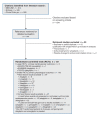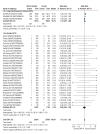Dipeptidyl peptidase-4 inhibitors and the risk of heart failure: a systematic review and meta-analysis
- PMID: 28459046
- PMCID: PMC5403656
- DOI: 10.9778/cmajo.20160058
Dipeptidyl peptidase-4 inhibitors and the risk of heart failure: a systematic review and meta-analysis
Abstract
Background: Given recent discrepant results from randomized controlled trials (RCTs), we examined the totality of RCT evidence assessing the association between dipeptidyl peptidase-4 (DPP-4) inhibitors and heart failure.
Methods: MEDLINE, Embase and ClinicalTrials.gov were searched without language restrictions to August 2016 for RCTs comparing DPP-4 inhibitors to placebo or no therapy for a period of 24 weeks or more. We included all heart failure outcomes when listed either as a serious adverse event or adverse event. Pooled analyses used random-effects.
Results: We identified 100 RCTs (n = 79 867) - 3 large cardiovascular-safety RCTs (SAVOR-TIMI 53[saxagliptin]/n = 16 492, EXAMINE[alogliptin]/n = 5380, and TECOS[sitagliptin]/n = 14 735), and 97 smaller RCTs with a primary outcome that was usually change in glycated hemoglobin. Virtually all RCTs were high-quality, multicentre, placebo-controlled trials. A total of 96% (1192/1244) of heart failure events were prespecified, blindly adjudicated and required hospital admission. Pooled results suggested a 13% increase in heart failure (relative risk [RR] 1.13, 95% confidence interval [CI] 1.01-1.26, I2 = 0%; 32 RCTs, n = 54 640, 1244 events). When including only the 3 large RCTs, the increase was similar, but not significant (RR 1.14, 95% CI 0.97-1.32; 3 RCTs, n = 36 543, 1169 adjudicated events; number needed to harm 246) owing to heterogeneity (I2 = 42%), which lead to wider CIs, because SAVOR-TIMI 53 showed increased heart failure (RR 1.26, 95% CI 1.06-1.49) and TECOS showed no effect (RR 1.00, 95% CI 0.83-1.19).
Interpretation: Despite pooled data from 79 867 patients, whether DPP-4 inhibitors increase heart failure overall or exhibit within-class differences remains unresolved. Our results highlight the importance of ongoing trials that are comparing DPP-4 inhibitors to placebo, although no large cardiovascular-safety RCTs are comparing different DPP-4 inhibitors to each other; consequently, these will address the overall but not class-difference question.
Conflict of interest statement
Competing interests: Subodh Verma has received speaker honoraria and/or grants from Amgen, AstraZeneca, Merck, Novartis, Sanofi, and Valeant. Ronald Goldenberg has received research support from AstraZeneca, Böehringer Ingelheim, Eli Lilly, GlaxoSmithKline, Merck, Novartis, Novo Nordisk, Takeda; has served on advisory panels for AstraZeneca, Böehringer Ingelheim, Eli Lilly, Merck, Novo Nordisk, and Takeda; has participated in speaker bureaus for AstraZeneca, Böehringer Ingelheim, Eli Lilly, Merck, and Novo Nordisk and Servier; and has served as a consultant for AstraZeneca, Böehringer Ingelheim, Eli Lilly, Merck, Novo Nordisk and Takeda. Deepak Bhatt discloses the following relationships - Advisory Board: Cardax, Elsevier Practice Update Cardiology, Medscape Cardiology, Regado Biosciences; Board of Directors: Boston VA Research Institute, Society of Cardiovascular Patient Care; Chair: American Heart Association Quality Oversight Committee; Data Monitoring Committees: Duke Clinical Research Institute, Harvard Clinical Research Institute, Mayo Clinic, Population Health Research Institute; Honoraria: American College of Cardiology (Senior Associate Editor, Clinical Trials and News, ACC.org), Belvoir Publications (Editor-in-Chief, Harvard Heart Letter), Duke Clinical Research Institute (clinical trial steering committees), Harvard Clinical Research Institute (clinical trial steering committee), HMP Communications (Editor-in-Chief, Journal of Invasive Cardiology), Journal of the American College of Cardiology (Guest Editor; Associate Editor), Population Health Research Institute (clinical trial steering committee), Slack Publications (Chief Medical Editor, Cardiology Today's Intervention), Society of Cardiovascular Patient Care (Secretary/Treasurer), WebMD (CME steering committees); Other: Clinical Cardiology (Deputy Editor), NCDR-ACTION Registry Steering Committee (Vice-Chair), VA CART Research and Publications Committee (Chair); Research Funding: Amarin, AstraZeneca (including for serving as the co-PI of SAVOR-TIMI 53), Bristol-Myers Squibb, Eisai, Ethicon, Forest Laboratories, Ischemix, Medtronic, Pfizer, Roche, Sanofi Aventis, The Medicines Company; Royalties: Elsevier (Editor, Cardiovascular Intervention: A Companion to Braunwald's Heart Disease); Site Co-Investigator: Biotronik, Boston Scientific, St. Jude Medical; Trustee: American College of Cardiology; Unfunded Research: FlowCo, PLx Pharma, Takeda. Kim Connelly has received support from Astra Zeneca/Bristol Myer Squibb, consultancy fees from Servier, Merck, Janssen and Boehringer Ingelheim, travel support from Bristol Myer Squibb and holds a patent with Boehringer Ingelheim for linagliptin and heart failure with preserved ejection fraction. Lawrence Leiter has received research funding from, has provided CME on behalf of, and/or has acted as an advisor to AstraZeneca, Böehringer Ingelheim, Eli Lilly, GlaxoSmithKline, Janssen, Merck, NovoNordisk, Pfizer, Sanofi, and Servier. All other authors have reported that they have no relationships relevant to the contents of this paper to disclose.Competing interests: See end of article.
Figures




Similar articles
-
Assessment of the Risk of Hospitalization for Heart Failure With Dipeptidyl Peptidase-4 Inhibitors, Saxagliptin, Alogliptin, and Sitagliptin in Patients With Type 2 Diabetes, Using an Alternative Measure to the Hazard Ratio.Ann Pharmacother. 2017 Jul;51(7):570-576. doi: 10.1177/1060028017698496. Epub 2017 Mar 1. Ann Pharmacother. 2017. PMID: 28622738
-
Efficacy and safety of DPP-4 inhibitors in patients with type 2 diabetes: Meta-analysis of placebo-controlled randomized clinical trials.Diabetes Metab. 2017 Feb;43(1):48-58. doi: 10.1016/j.diabet.2016.09.005. Epub 2016 Oct 10. Diabetes Metab. 2017. PMID: 27745828
-
Heart Failure Hospitalization with DPP-4 Inhibitors: A Systematic Review and Meta-analysis of Randomized Controlled Trials.Indian J Endocrinol Metab. 2019 Jan-Feb;23(1):128-133. doi: 10.4103/ijem.IJEM_613_18. Indian J Endocrinol Metab. 2019. PMID: 31016167 Free PMC article.
-
Safety of dipeptidyl peptidase-4 inhibitors in older adults with type 2 diabetes: a systematic review and meta-analysis of randomized controlled trials.Ther Adv Drug Saf. 2022 Jan 21;13:20420986211072383. doi: 10.1177/20420986211072383. eCollection 2022. Ther Adv Drug Saf. 2022. PMID: 35111291 Free PMC article. Review.
-
Effect of dipeptidyl peptidase-4 inhibitors on heart failure: A meta-analysis of randomized clinical trials.Int J Cardiol. 2016 May 15;211:88-95. doi: 10.1016/j.ijcard.2016.02.146. Epub 2016 Mar 2. Int J Cardiol. 2016. PMID: 26991555 Review.
Cited by
-
Cardiovascular risks in type 2 diabetes and the interpretation of cardiovascular outcome trials.Diabetes Metab Syndr Obes. 2019 Apr 4;12:447-455. doi: 10.2147/DMSO.S188705. eCollection 2019. Diabetes Metab Syndr Obes. 2019. PMID: 31040709 Free PMC article. Review.
-
Fibrosis of the diabetic heart: Clinical significance, molecular mechanisms, and therapeutic opportunities.Adv Drug Deliv Rev. 2021 Sep;176:113904. doi: 10.1016/j.addr.2021.113904. Epub 2021 Jul 29. Adv Drug Deliv Rev. 2021. PMID: 34331987 Free PMC article. Review.
-
Effect of Dipeptidyl Peptidase 4 Inhibitors on Cardiovascular Events in Type-2 Diabetes Patients with Renal Impairment: A Systematic Review and Meta-analysis.Indian J Endocrinol Metab. 2020 Mar-Apr;24(2):143-149. doi: 10.4103/ijem.IJEM_568_19. Epub 2020 Apr 30. Indian J Endocrinol Metab. 2020. PMID: 32699780 Free PMC article.
-
Challenges to hemoglobin A1c as a therapeutic target for type 2 diabetes mellitus.J Gen Fam Med. 2019 Apr 4;20(4):129-138. doi: 10.1002/jgf2.244. eCollection 2019 Jul. J Gen Fam Med. 2019. PMID: 31312579 Free PMC article. Review.
-
DPP-4 inhibitors and GLP-1RAs: cardiovascular safety and benefits.Mil Med Res. 2022 Aug 20;9(1):45. doi: 10.1186/s40779-022-00410-2. Mil Med Res. 2022. PMID: 35986429 Free PMC article. Review.
References
-
- Connelly KA, Yan AT, Leiter LA, et al. Cardiovascular implications of hypoglycemia in diabetes. Circulation. 2015;132:2345–50. - PubMed
-
- Gilbert RE, Krum H. Heart failure in diabetes: effects of anti-hyperglycaemic drug therapy. Lancet. 2015;385:2107–17. - PubMed
-
- McMurray JJ, Gerstein HC, Holman RR, et al. Heart failure: a cardiovascular outcome in diabetes that can no longer be ignored. Lancet Diabetes Endocrinol. 2014;2:843–51. - PubMed
-
- Scirica BM, Bhatt DL, Braunwald E, et al. SAVOR-TIMI 53 Steering Committee and Investigators. Saxagliptin and cardiovascular outcomes in patients with type 2 diabetes mellitus. N Engl J Med. 2013;369:1317–26. - PubMed
-
- Scirica BM, Braunwald E, Raz I, et al. SAVOR-TIMI 53 Steering Committee and Investigators. Heart failure, saxagliptin, and diabetes mellitus: observations from the SAVOR-TIMI 53 randomized trial. Circulation. 2014;130:1579–88. - PubMed
LinkOut - more resources
Full Text Sources
Other Literature Sources
Miscellaneous
